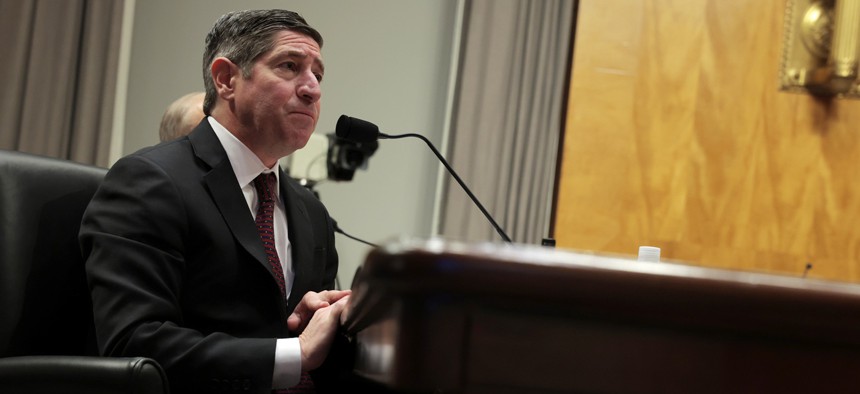
Office of Personnel Management Director Scott Kupor joined the agency earlier this month. Anna Moneymaker/Getty Images
New OPM head plans to cement focus on efficiency
Scott Kupor said he won’t be taking orders from DOGE, though he’s “happy to partner with people” that are helpful to his overall goals for the agency.
The new, Senate-confirmed head of the Office of Personnel Management, venture capital alum Scott Kupor, says that he wants to operationalize the focus on efficiency in his agency and throughout government, but that OPM won’t be taking orders from the Department of Government Efficiency.
“OPM is its own agency,” Kupor told reporters Monday when asked about its relationship with DOGE moving forward. “To the extent that they’re helpful in the overall goals and objectives we have, then we’re happy to partner with people, but we’re going to ultimately make the decisions that we think are in the best interests of OPM.”
The agency, charged with implementing personnel policy for the federal government, was one of the first landing spots for the government-slashing DOGE at the start of the Trump administration.
In February, federal employees started getting emails from an OPM address asking them to send in five bullets of what they did over the last week, a practice that remains in some agencies but has been abandoned in others.
“I think it’s something that we should look at and see, like, are we getting the value out of it that at least the people who put it in place thought they were,” Kupor said.
Other policies may be harder to reverse. Kupor is entering an agency where the headcount cuts DOGE became known for are anticipated to reduce the OPM workforce by a thousand people.
The agency is down by 322 employees since the start of Trump 2.0, OPM says. Once voluntary separations are finalized by the end of the year, OPM will be down from 3,110 employees when Trump took office to about 2,000, or around one-third of the agency, according to OPM.
Most of those are voluntary departures, such as those that retired early or took the administration’s voluntary departure incentive, another feature of OPM in the first days of the Trump administration. But nearly 130 feds at OPM were laid off.
Kupor, who only started the job last week, said that he may have to make up for some of those losses. The agency is looking at what gaps in service exist, which need to be filled, which can be made up for with technology and what was “nice to have,” but not essential.
“I’m quite certain that we may have, you know, made some mistakes where we need to hire back some people,” he told reporters.
OPM is also aiming to cut the 1,200 contractors it had as of the start of the year in half by the end of 2026, said Kupor.
The new OPM head spent the last 15 plus years at Andreessen Horowitz, the founders of which have backed Trump. He said that he got the gig at OPM by answering a general call for those interested in administration jobs during the transition, after which he was interviewed by the likes of former operational head of DOGE and longtime Elon Musk associate, Steve Davis, who is no longer part of DOGE.
Motivated by “the idea of fiscal responsibility,” Kupor’s priorities include making OPM a leader in operational efficiency and helping — but not forcing help upon — other agencies, he said, noting that he wants to make sure other federal agencies don’t see OPM as “aggressive.”
The longtime Silicon Valley alum also wants to change performance management in the government, he said, by incentivizing efficiency and cost savings.
DOGE started the process, he said, and “we have to actually institutionalize those things and make operational efficiency quite frankly a first class citizen.” Kupor told reporters that he’s worked “OPM equals other people’s money” into an internal memo he’s working on.
A third objective for his tenure is preparing the government workforce to lean forward on artificial intelligence, said Kupor, offering the potential for AI to summarize comments submitted on government regulations as a likely use case.
“There’s very good technology people here,” he said when asked about the government’s tech workforce. “We’re probably missing people who are, like, super conversant with very modern, AI-related stuff.”
Since Trump took office again in January, many government tech teams have been hit with layoffs or even shuttered entirely as the administration has sought to shrink the size of the government’s workforce.
OPM’s own technology shop is estimated to be cut down by over 200 employees, from 389 in fiscal 2025 to 170 full-time employees projected for fiscal 2026, per the agency’s budget justification. And the loss of staff and ongoing hiring freeze is putting the agency’s Postal Service Health Benefits Program at risk of failure, according to OPM’s inspector general.
“We’ve got to really just rethink our entire recruiting efforts,” Kupor said. “I want every really smart person in this country to wake up every day and say, ‘you know what, I want to go work for the government because I can work on super hard problems that are very complex.’”







